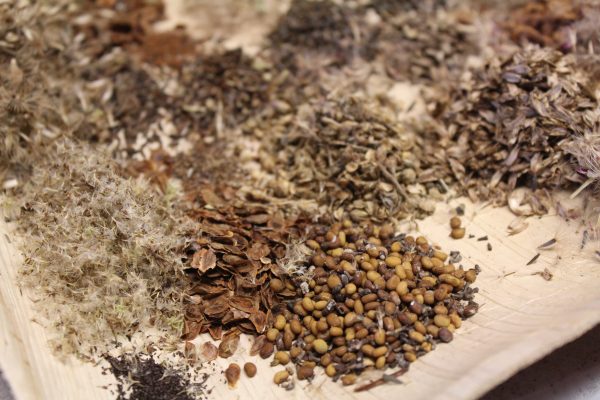This year the staff and volunteers collected 73 species of seeds, coming to a total of 10.6 lbs. They were collected on approximately 64 different days in 2016.
We emphasized the collection of woodland seed, as we have prioritized several of our wooded areas as restoration units in need of seed mixes. This resulted in 2.9 lbs of creek oats, 1.8 lbs of rye (Canada and Virginia), and 1.1 lbs of beak grass. The woodland forbs were a more challenging group to collect seeds from as the weather this year seemed to extend the bloom time of many species, but we were able to collect some joe pye weed, American bellflower, woodmint, mistflower, and wingstem to include in our woodland seed mixes.
For our woodland units, the objective for the seed mixes is to get plants established to help cover the bare soil and decrease erosion, out-compete invasive plants, and establish grasses that will be a continuous fuel for a prescribed burn in the future. For the prairie units, the seed mixes are more aimed to increase species diversity.

Woods 18 and 20 are located behind the cabin and are frequently inundated with floodwater from the creek. The euonymus in these units was treated twice with a foliar spray of 3% glyphosate in the fall of 2015. This was followed up with plantings in 2015 and 2016. In the spring of 2016, we transplanted trillium, ginger, bluebells, and false rue anemone from Woods 26 (across the creek) and Woods 23 (Mulch Pile Woods) into Woods 18. We will observe their survivorship this spring and continue to transplant (rescue) early spring bloomers from areas that will be affected by the MDC Sewer project in approx. 2020. Despite the plantings and transplantings, there is still much bare ground in this area since the euonymus died back. This winter we will spread a mix of the woodland seeds mentioned above.
Woods 4 and 5 have also been treated with a foliar spray of 3% glyphosate to manage the euonymus. Part of Woods 4 has been planted in the fall of 2015 and 2016. Woods 5 is the largest unit that will be seeded this year. According to our recommended seeding rate of 160 seeds per acre, this area needs 3,600,000 seeds.
Prairie 1 and 2 (North Prairie and South Prairie) will be seeded in specific areas. This year several volunteer days were spent removing the blackberry in Prairie 1 near the sitting circle and we will throw a seed mix there this winter. Burning the South Prairie this year will leave the unit with bare soil for a while, which is a good opportunity for a seed mix. We used vegetation monitoring data to determine which sections of the South Prairie have the lowest plant diversity or highest presence of invasive species. Those areas will be seeded in an attempt to increase plant diversity.
Other 5 is a wooded area adjacent to neighboring property. Several Friday Horticulture Volunteer days have been dedicated to clearing out bush honeysuckle in this area, and there is still more honeysuckle to be removed. The euonymus in this area was treated twice with a 3% glyphosate foliar spray this fall. Removing the honeysuckle greatly opened the canopy and we will be spreading a mix of creek oats, beak grass, and turtlehead.
Other 6 includes a prairie extension area that was planted this fall. Because this area is visible from the driveway and to neighbors, we are planting and seeding prairie species that are short to medium size. For example, we will not establish cup plant or big bluestem in this area. Some species found in this seedmix include white wild indigo, purple coneflower, sneezeweed, seedbox, and grey-headed coneflower.
Four of our partner schools will also received seedmixes for their school gardens.

Seed collection and distribution steps:
- Collect seeds when they’re mature, typically later in the fall
- Clean seeds – remove leaf litter, insects, and expose the true seed
- Weigh seeds and store in plastic bags
- Enter seed data into Excel spreadsheet – date collected, location, species, weight, seeds/ounce
- Store the seeds in the refrigerator to simulate winter weather
- Determine the LREC restoration units and schools that will need seed mixes
- Measure areas by square foot
- Multiply the area by the recommended 160 seeds per square foot to determine how many seeds are needed
- Plan on Excel spreadsheet the amount of each species for each seed mix
- Weigh out seeds to create seed mixes
- Spread the seeds on a snowy day and do the stomping dance
Seed Data
Our seed data is vital for us to determine what seeds we have available to create the mixes. This data is also used to inform restoration planning for the upcoming year. We use past seed collection data combined with data from our weekly phenology monitoring to find the average date range for when different species are ready to be collected. While the weather affects when a plant is ready to produce seed, having an average specific to the LREC helps give us a baseline for what to keep an eye on over the peak weeks.
We would like to thank our volunteers for the countless hours they spent collecting, cleaning, and spreading seeds with us.